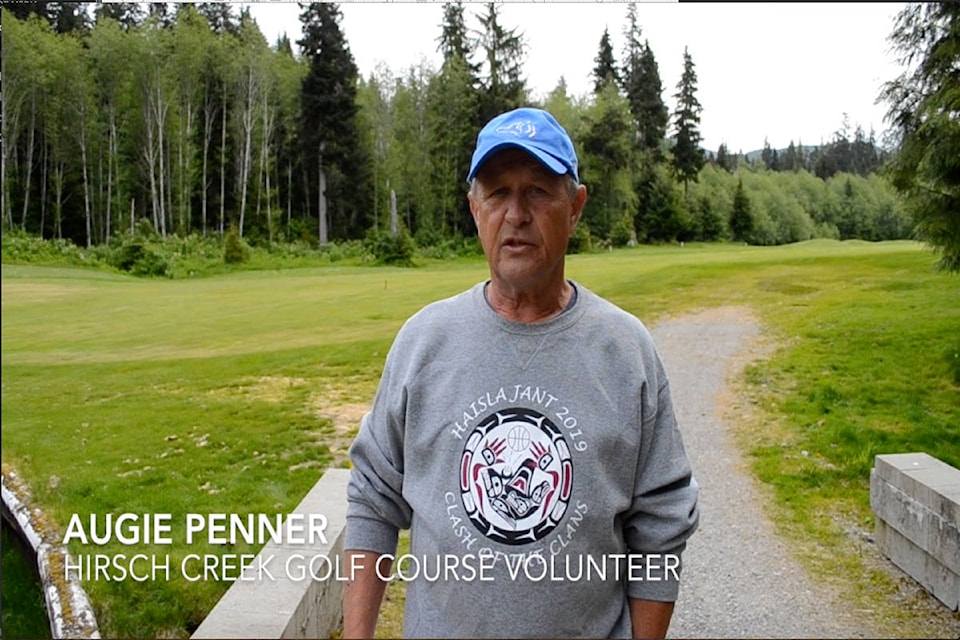Following the tradition set by Joe Atamchuck, Augie Penner saves the fry that keeps spawning at the Hirsch Creek Golf Course.
The golf course has ponds that runoff from the Kitimat River but during the highwater season, from October to November, salmon are known to lay their eggs in these ponds.
As the fish spawn in the shallow spring waters on the course, they wait two years before attempting to swim down into the river. The problem is the water in these channels, which connect to the Coho Flat Trails, dry up during the summer seasons; killing all the fry.
Trying to keep the fish alive, Joe Atamchuck started trapping them in the ponds with a little fishing net and would transfer them into the Kitimat river, giving the fingerlings a chance of survival.
However, since Joe passed away in 2012, golf course volunteer and lifetime member, Augi Penner, keeps the tradition alive and continues to catch the fry and releasing them into the Kitimat River.
“This way here, the fish have a chance to go on. Otherwise, depending on the rainy season, they would have to wait until October to get flushed out,” Penner said.
Penner has caught more than 375 fish in the last couple of weeks but usually stops in the summertime since the remaining fingerlings are first-year fishlings.
“I try and stop after a while because you start trapping the first years and you don’t want to bring them to the creek because they got another year left. Plus it’s a fulltime job,” Penner said.
Looking for a more permanent solution, Penner brought a Kitimat hatchery worker to check out the pond last year who then passed the inquiry down to the federal fisheries in Kitimat and Terrace.
After getting word about the pond issue, federal fishery biologists and project engineers from Terrace surveyed the river runoff and are planning on making a final decision this summer.
“There are two options, you either totally stop them from coming up or you enhance [the pond]. […] If you [properly enhance the pond], it’s not just less work but it’s better for the fish,” Penner said.
Penner hopes to get permission and money so he can restructure the pond, giving the fish a better chance of survival. With the approval of the federal fisheries, Penner plans on digging out the pond and installing six-foot deep holes for higher water levels during the summertime and adding a water feature for constant water circulation.
“Hopefully the fisheries have [funds] for enhancements, which would be a win-win situation for everyone involved,” Penner said.
Continuing to volunteer his time, Penner has already saved up $4,500 of his own money for this project and is willing to donate his labour to set up a better system for the fish.
“What I do [as a volunteer] on the course is I chop up a lot of wood and sell it. […] I have about $4,500 saved up and would usually give it directly to the golf course, but this is one project I want to get done so the fish have a place to live. Plus the golf course gets a win out of it because they get a nice water feature,” Penner said.
“I’m willing to put the time in but fisheries like to get things bing, bang, boom, done. […] And the cost might go up because the fisheries want the work done faster. Meaning we’d probably have to get another machine in there so we could get it done in fewer days.”
Looking for additional donations, Penner is also reaching out to local contractors and seeing if they’re willing to donate any materials but is having a hard time figuring out what he should be asking for until the federal fisheries give a clear answer on what the next steps are.
According to Penner, the window to complete projects for fish habitats is between July and August because the fish aren’t spawning and the waters are relatively low, making it easier working conditions.
“Hopefully that’s the timeframe but if it’s not this year it’ll probably be next year. If I have to do the trapping for another year so be it, but if I get the green light [this year] that’d be nice,” Penner said.
READ MORE: Ancient fish weirs in Minette Bay shine a light on Haisla’s past
